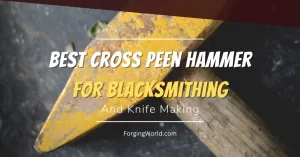Blacksmithing, the art and skill of working with metal, has been a proud tradition for centuries. It has been used to make everything from tools and weapons to decorative pieces of art.
Nowadays, it has undergone a bit of a renaissance with more hobbyists taking up the craft as an enjoyable way to pass time and create beautiful works of art out of metal.
In this article, I want to share with you the basics of how to get started as a blacksmith at home. From what materials and tools you need, to setting up your forge, and safety tips every home blacksmith needs to know.
Let’s get started!
Can You Blacksmith at Home?
Absolutely! Anyone can start blacksmithing at home and it doesn’t have to be expensive. All you need are a few basic tools such as a hammer, charcoal grill, and some safety gear to get started.
However, just because you can doesn’t mean you should. Before starting your blacksmithing home business, you should understand that forging is a very noisy and loud hobby that tends to upset most people’s neighbors.
Also, smithing requires a lot of patience and can be very dangerous if you don’t pay attention. Therefore, it is important to always keep safety in mind at all times and make sure you have the necessary protective gear.
What You Need to Start Blacksmithing at Home
Before you start blacksmithing at home, you will need the following basic items:
- Forge (Charcoal Grill)
- Anvil (Large Stone/Railroad Track)
- Hammer (Claw Hammer/Sledgehammer)
- Tongs (Pliers)
- Safety Gear (Gloves/Goggles/Apron)
Before you go on a shopping spree, buying everything I mentioned above, let me go over what each item is used for and some possible alternatives you may already have around the house.
Forge (Charcoal Grill)
A forge is considered by many blacksmiths to be the heart of a blacksmithing setup. It is used to heat up metal so it can be worked with and shaped. Most store-bought forges use propane and are one of the most expensive costs to blacksmithing at home.
Luckily, you don’t need to buy a forge to get started.
Many hobbyists prefer to build their own forge at home with some basic tools and materials. You can forge using a propane torch or even an old charcoal grill along with some firebricks to create a homemade forge that will be just as effective and cheaper.
Anvil (Large Stone/Railroad Track)
The next item you will need to blacksmith at home is an anvil. This heavy metal block is used to shape and flatten hot metal with a hammer.
Basic anvils can be purchased online for as little as $40. However, you can also use a large stone or a piece of railroad track as an alternative.
Hammer (Claw Hammer/Sledgehammer)
You will traditionally need different hammer weights to do different kinds of blacksmithing jobs.
However, to start your blacksmithing journey at home, a simple claw hammer or sledgehammer (if you have the arms for it) will do the trick.
Tongs (Pliers)
Tongs are used to securely and safely hold metal pieces while being worked on in the forge. Blacksmithing tongs typically have a long handle to help keep your hands away from the heat.
If you are just starting out then a pair of pliers should be sufficient until you decide to upgrade. Just be sure to use them with a pair of heavy-duty gloves to keep your hands safe.
Safety Gear (Gloves/Goggles/Apron)
The most important part of blacksmithing is safety. Although I left this for last, it should always be the first thing you consider when starting any blacksmithing job.
I’ve seen many home blacksmiths use kitchen gloves and regular safety glasses as an alternative to expensive protective gear. Although this is not ideal, it will do the job in a pinch.
Always make sure you have appropriate fire-retardant clothing and safety gear such as heat-resistant gloves, goggles, and an apron to keep you safe while smithing at home.
If you’re planning on skimping on the tools, don’t skimp on the safety gear! You’ll thank me when you avoid your first nasty burn.
Setting Up Your Home Forge
Now that you have all the tools and safety gear, it’s time to set up your forge.
If you opted to buy a store-bought propane forge, then you just need to follow the manufacturer’s instructions for setup.
For those of you who went with a DIY route, here are some basic steps:
1. Gather your firebricks and place them in a rectangular shape that will fit on top of your charcoal grill. Leave about an inch of space between each brick.
2. Place a steel grate on top of the firebricks. This will provide an even surface for your forge and keep your tools from falling into the coals.
3. Add charcoal to the grill till it is filled about halfway up the bricks, then light it up!
4. Once the coals are burning, use a large metal plate as a lid to regulate the heat and airflow.
Practice lighting the forge, adjusting the airflow, and getting comfortable with moving hot metal around in it until you’re ready to try your hand at blacksmithing!
Basic Home Blacksmithing Techniques
Once you have your forge set up, it’s time to try some basic blacksmithing techniques that will help you get started.
Forging: This is the process of heating metal and hammering it into a different shape. This can be used to create items such as hooks, brackets, or blades.
Welding: This is the process of joining two pieces of metal together with heat. This can be done using traditional forge welding or modern gas welding techniques.
Heat Treatment: Heat treatment is a process of heating and cooling metal in order to strengthen it and make it more durable. This is typically used for high-quality blades and tools.
Now you have all the knowledge you need to begin your home blacksmithing journey! Have fun and stay safe!
Tips for Blacksmithing at Home
Now that you have the basics down, here are some tips to help you get started in blacksmithing.
Start small and simple: When beginning your journey, it’s important to start with small and simple projects. This will help you get familiar with the tools and basic techniques of blacksmithing before attempting more complex projects.
Get an experienced mentor: Whenever possible, it is beneficial to find a blacksmith who can give you some guidance as you learn. This can save you a lot of time and mistakes as you get started.
Take your time: Blacksmithing is not something that should be rushed. Take your time to ensure that each step is done correctly and with safety in mind. This will help prevent any accidents or mistakes.
Read up on blacksmithing: There are many great books and online resources available to help you learn the basics of blacksmithing. Take some time to read up on the fundamentals before getting started.
Join online blacksmithing groups: There are many online communities dedicated to blacksmithing that can provide you with helpful advice. Take the time to join one of these groups and reach out to get some tips from more experienced smiths.
Blacksmithing is a great way to express your creativity and make amazing projects at home. With the right tools, safety gear, and knowledge, you can begin your own home blacksmithing journey. Good luck!


